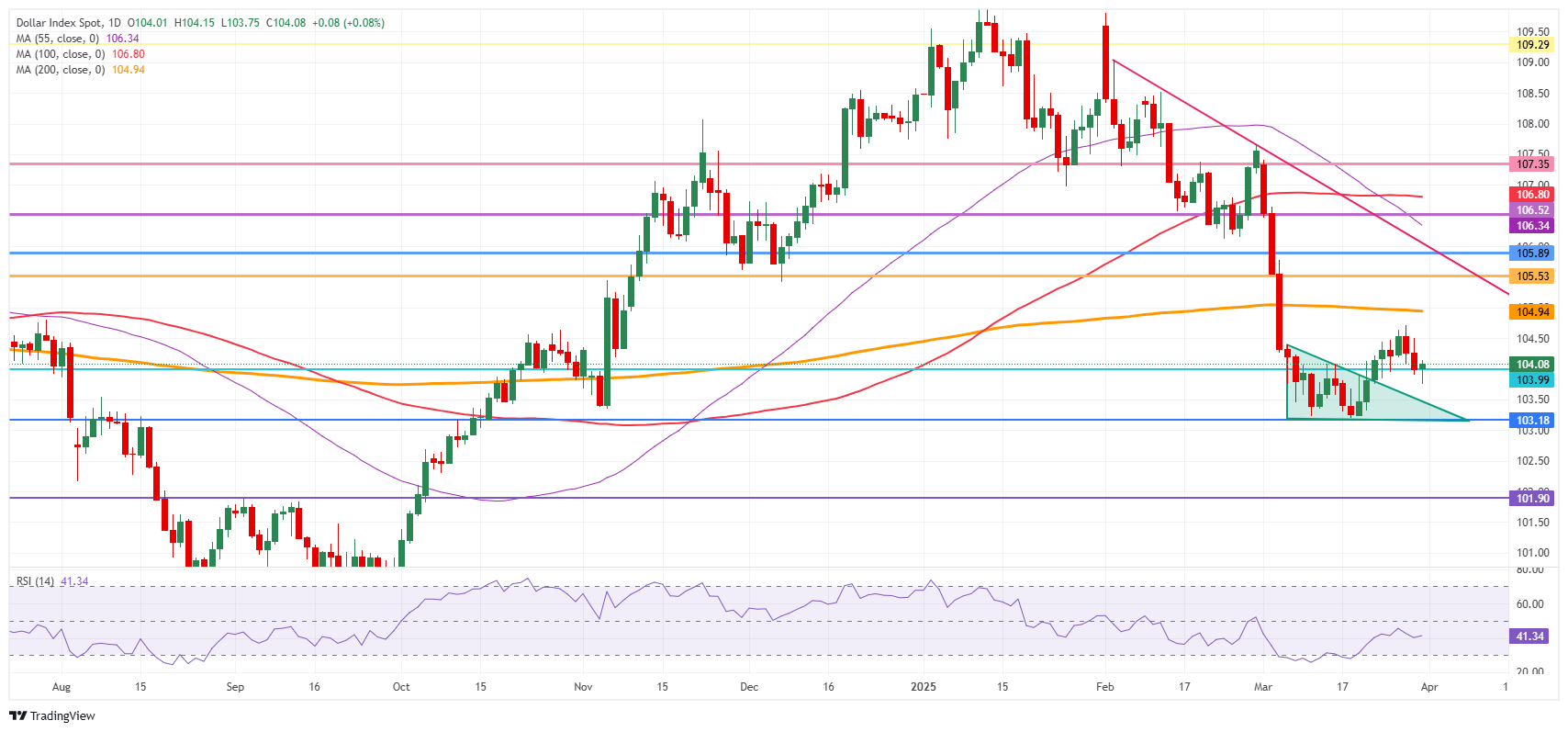US Dollar Index no longer considered safe-haven asset with traders feeling equities, heading into bonds and Gold

- Equities plunge, Bond prices spike and Gold surges to new all-time high ahead of Trump’s reciprocal tariffs.
- US President Trump confirmed on Sunday that all countries will be targeted.
- The US Dollar Index trades stable around 104.10, with no safe-haven flows in the Greenback.
The US Dollar Index (DXY), which tracks the performance of the US Dollar (USD) against six major currencies, trades flat on Monday and sees traders not placing positions in the Greenback. The DXY is completely left in the dark while Equities are selling off, Bond prices are spiking higher, and Gold has hit a fresh all-time high above $3,100 earlier in the day. The move comes after United States (US) President Donald Trump reiterated on Sunday at Airforce One that all countries will fall under reciprocal tariffs on Wednesday’s ‘Liberation Day’, Bloomberg reports.
One thing that became clear last week is that the US Dollar (USD) is moving depending on US economic data, and fears of stagflation or recession are weakening the Greenback. Thus, Monday’s focus will shift to March’s Chicago Purchase Manager’s Index and the Dallas Fed Manufacturing Business Index. Contractions and slow downs in those economic data points could trigger another leg lower in the DXY.
Daily digest market movers: Gearing up for Chicago PMI
- At 13:45 GMT, the Chicago Purchase Manager’s Index (PMI) will be released. Expectations are for 45.4, just one tick lower from the previous 45.5.
- At 14:30 GMT, the Dallas Federal Reserve (Fed) will release the Manufacturing Business Index for March. No forecast is available, with the previous reading at -8.3.
- Equities are diving lower with losses between 1.0% to 2.0% crossing from Asia over Europe and into US futures.
- According to the CME Fedwatch Tool, the probability of interest rates remaining at the current range of 4.25%-4.50% in May’s meeting is 82.1%. For June’s meeting, the odds for borrowing costs being lower stand at 81.2%.
- The US 10-year yield trades around 4.20%, a substantial drop lower and the reason why the Fedwatch Tool sees elevated chances for a rate cut in June.
US Dollar Index Technical Analysis: No longer exceptional
The US Dollar Index (DXY) provided an answer last week and this Monday to one question that was on traders’ minds. Tariffs clearly do not impact the US Dollar. Instead, the US economic data looks to be impacting the Greenback, as seen on Friday with the University of Michigan Consumer Sentiment and elevated inflation expectations reading, which pushed the US Dollar lower. The recession or stagflation fear no longer supports a stronger US Dollar, and more evidence of stagflation could push the DXY lower from here.
A return to the 105.00 round level could still occur in the coming days, with the 200-day Simple Moving Average (SMA) converging at that point and reinforcing this area as a strong resistance at 104.94. Once broken through that zone, a string of pivotal levels, such as 105.53 and 105.89, could limit the upward momentum.
On the downside, the 104.00 round level is the first nearby support, although it looks bleak after being tested on Friday and again this Monday. If that level does not hold, the DXY risks falling back into that March range between 104.00 and 103.00. Once the lower end at 103.00 gives way, watch out for 101.90 on the downside.

US Dollar Index: Daily Chart
Risk sentiment FAQs
In the world of financial jargon the two widely used terms “risk-on” and “risk off” refer to the level of risk that investors are willing to stomach during the period referenced. In a “risk-on” market, investors are optimistic about the future and more willing to buy risky assets. In a “risk-off” market investors start to ‘play it safe’ because they are worried about the future, and therefore buy less risky assets that are more certain of bringing a return, even if it is relatively modest.
Typically, during periods of “risk-on”, stock markets will rise, most commodities – except Gold – will also gain in value, since they benefit from a positive growth outlook. The currencies of nations that are heavy commodity exporters strengthen because of increased demand, and Cryptocurrencies rise. In a “risk-off” market, Bonds go up – especially major government Bonds – Gold shines, and safe-haven currencies such as the Japanese Yen, Swiss Franc and US Dollar all benefit.
The Australian Dollar (AUD), the Canadian Dollar (CAD), the New Zealand Dollar (NZD) and minor FX like the Ruble (RUB) and the South African Rand (ZAR), all tend to rise in markets that are “risk-on”. This is because the economies of these currencies are heavily reliant on commodity exports for growth, and commodities tend to rise in price during risk-on periods. This is because investors foresee greater demand for raw materials in the future due to heightened economic activity.
The major currencies that tend to rise during periods of “risk-off” are the US Dollar (USD), the Japanese Yen (JPY) and the Swiss Franc (CHF). The US Dollar, because it is the world’s reserve currency, and because in times of crisis investors buy US government debt, which is seen as safe because the largest economy in the world is unlikely to default. The Yen, from increased demand for Japanese government bonds, because a high proportion are held by domestic investors who are unlikely to dump them – even in a crisis. The Swiss Franc, because strict Swiss banking laws offer investors enhanced capital protection.
BRANDED CONTENT
Choosing a broker that aligns with your trading needs can significantly impact performance. Our list of the best regulated brokers highlights the best options for seamless and cost-effective trading.




